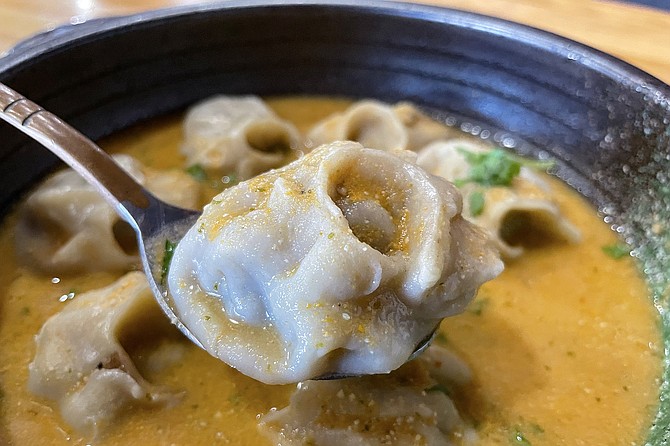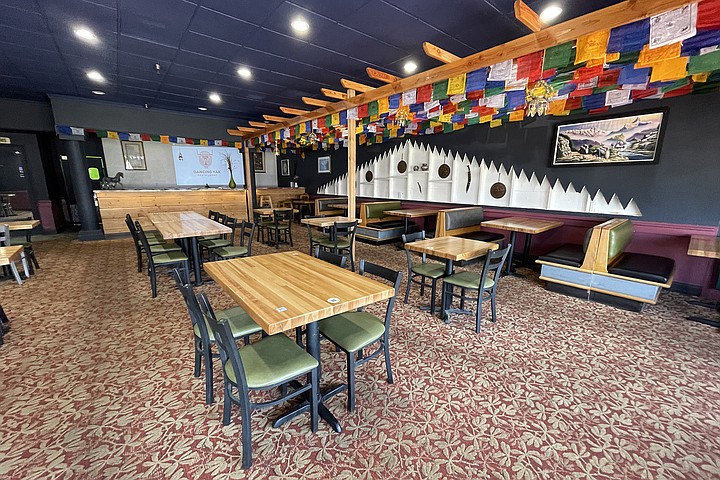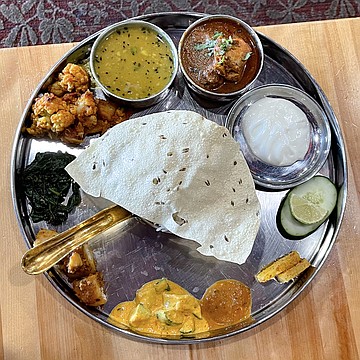 Facebook
Facebook
 X
X
 Instagram
Instagram
 TikTok
TikTok
 Youtube
Youtube

The first time I walked into The Dancing Yak, I didn’t stay long. The Miramar restaurant opened this winter, an expansion by Taste of the Himalayas, the local Indian restaurant chain currently operating six county locations, from Carlsbad to Point Loma. I’d tried a couple of these spots over the years, generally enjoying my typical orders of lamb, chicken, and spinach curries.
What I hadn’t tried is the namesake meat served at The Dancing Yak. But when I showed up that late afternoon, there wasn’t any yak available. “We also serve chicken…” my server implored, as I walked out the door without ordering anything. I wasn’t hearing it. Yak was the whole reason I’d shown up.
Yaks are native to habitats over 10,000 feet, such as the Tibetan plateau, and Yak meat is a rare find in the United States. What I knew going in is that the red meat tastes similar to beef, yet lower in cholesterol and saturated fats than chicken. Lower even than skinless chicken. It has to do with how the ox-like animal manages to thrive in the thin, Himalayan air.

A couple months would go by before I returned. On this day, the restaurant did have yak in plentiful supply, so I immediately ordered whichever examples of it I could find. It was being served in momos, the style of dumplings served in Nepal and Tibet, and in a Nepali rendition of chow mein, the noodle dish from China, across the border to Nepal’s north.
The momo dishes were particularly intriguing. Offered with a choice of chicken vegetables or yak, Dancing Yak’s momos are served three ways, ranging from $12-14 for vegetable dumplings, to $19-21 for the yak. Chili momo are fried and served in sweet-and-sour sauce, while steamed momo are served with tomato and coriander dipping sauce. Our server steered us to the jhol momo, which sits the steamed dumplings in a broth of tomato and sesame.

On first impression, they look like rustic versions of xiao long bao, the famous soup dumplings with thin wrappers and delicate twists at the top. Dancing Yak’s momo dumplings are less delicate, yet similarly constructed. Filled with minced yak, they may not burst with soupy flavor the way great bao do, but they certainly deliver the meat. The yak didn’t taste particularly gamey, as I’d imagined. It simply tasted like lean beef.
Meanwhile, much of the dumpling’s taste came from that tomato and sesame broth. Simple and warm, with a bit of soy sauce giving it only light salt, it combined flavors I know well and adore, but presented them in a different way. I can’t help imagine the people of the Himalayas encountering tomatoes for the first time, and adapting recipes to include the ingredient, which originated in the Andes mountains, half a world away.

Use of seasoning only got more interesting as I moved to the yak chow mein ($16). Here, you could see the yak meat more clearly, at least small, chipped portions of it, spread throughout the stir fry of vegetables and wheat noodles. Again, the yak itself tasted similar enough to lean beef that I forgot I was eating anything different or new. Instead, what claimed my focus was the cumin, and other seasonings. Chow mein is cooked in variation all over China, and I’ve ordered chow mein hundreds of times from Chinese restaurants, but it’s never quite tasted like this. It’s familiar, and comforting, yet still something new, yet mostly I remember how it let me experience chow mein in a new and different way.
Finally, we did get around to the chicken, by ordering a chicken thali. In Nepal, thali essentially means plate, and thali is used to describe a meal featuring many small dishes arranged on the same plate, with rice and flatbread. Ours was a chicken curry, served with small portions of potatoes, spinach, cucumber, lentil soup, fried cauliflower, and a sort of pickled radish.

Nepal, of course, borders India to its south, so it makes perfect sense most of this resembled Indian fare. The flatbread was a sort of papadum, and the chicken curry resembled a north Indian curry, though maybe a bit earthier. But when it came to the side dishes, I couldn’t help be reminded of the banchan of Korean restaurants. The small vegetable dishes likewise offered small, very flavorful bites.
Thali makes for a well-rounded, enjoyable meal. And has nothing to do with yak. It turns out, the real reason to eat at Dancing Yak isn’t to try yak. It’s to eat as the Nepali do. One side of dining room even features a bank of low tables, so diners may sit on the floor as they eat. I may try that next time, and either way I will be content to order the chicken.


The first time I walked into The Dancing Yak, I didn’t stay long. The Miramar restaurant opened this winter, an expansion by Taste of the Himalayas, the local Indian restaurant chain currently operating six county locations, from Carlsbad to Point Loma. I’d tried a couple of these spots over the years, generally enjoying my typical orders of lamb, chicken, and spinach curries.
What I hadn’t tried is the namesake meat served at The Dancing Yak. But when I showed up that late afternoon, there wasn’t any yak available. “We also serve chicken…” my server implored, as I walked out the door without ordering anything. I wasn’t hearing it. Yak was the whole reason I’d shown up.
Yaks are native to habitats over 10,000 feet, such as the Tibetan plateau, and Yak meat is a rare find in the United States. What I knew going in is that the red meat tastes similar to beef, yet lower in cholesterol and saturated fats than chicken. Lower even than skinless chicken. It has to do with how the ox-like animal manages to thrive in the thin, Himalayan air.

A couple months would go by before I returned. On this day, the restaurant did have yak in plentiful supply, so I immediately ordered whichever examples of it I could find. It was being served in momos, the style of dumplings served in Nepal and Tibet, and in a Nepali rendition of chow mein, the noodle dish from China, across the border to Nepal’s north.
The momo dishes were particularly intriguing. Offered with a choice of chicken vegetables or yak, Dancing Yak’s momos are served three ways, ranging from $12-14 for vegetable dumplings, to $19-21 for the yak. Chili momo are fried and served in sweet-and-sour sauce, while steamed momo are served with tomato and coriander dipping sauce. Our server steered us to the jhol momo, which sits the steamed dumplings in a broth of tomato and sesame.

On first impression, they look like rustic versions of xiao long bao, the famous soup dumplings with thin wrappers and delicate twists at the top. Dancing Yak’s momo dumplings are less delicate, yet similarly constructed. Filled with minced yak, they may not burst with soupy flavor the way great bao do, but they certainly deliver the meat. The yak didn’t taste particularly gamey, as I’d imagined. It simply tasted like lean beef.
Meanwhile, much of the dumpling’s taste came from that tomato and sesame broth. Simple and warm, with a bit of soy sauce giving it only light salt, it combined flavors I know well and adore, but presented them in a different way. I can’t help imagine the people of the Himalayas encountering tomatoes for the first time, and adapting recipes to include the ingredient, which originated in the Andes mountains, half a world away.

Use of seasoning only got more interesting as I moved to the yak chow mein ($16). Here, you could see the yak meat more clearly, at least small, chipped portions of it, spread throughout the stir fry of vegetables and wheat noodles. Again, the yak itself tasted similar enough to lean beef that I forgot I was eating anything different or new. Instead, what claimed my focus was the cumin, and other seasonings. Chow mein is cooked in variation all over China, and I’ve ordered chow mein hundreds of times from Chinese restaurants, but it’s never quite tasted like this. It’s familiar, and comforting, yet still something new, yet mostly I remember how it let me experience chow mein in a new and different way.
Finally, we did get around to the chicken, by ordering a chicken thali. In Nepal, thali essentially means plate, and thali is used to describe a meal featuring many small dishes arranged on the same plate, with rice and flatbread. Ours was a chicken curry, served with small portions of potatoes, spinach, cucumber, lentil soup, fried cauliflower, and a sort of pickled radish.

Nepal, of course, borders India to its south, so it makes perfect sense most of this resembled Indian fare. The flatbread was a sort of papadum, and the chicken curry resembled a north Indian curry, though maybe a bit earthier. But when it came to the side dishes, I couldn’t help be reminded of the banchan of Korean restaurants. The small vegetable dishes likewise offered small, very flavorful bites.
Thali makes for a well-rounded, enjoyable meal. And has nothing to do with yak. It turns out, the real reason to eat at Dancing Yak isn’t to try yak. It’s to eat as the Nepali do. One side of dining room even features a bank of low tables, so diners may sit on the floor as they eat. I may try that next time, and either way I will be content to order the chicken.
Comments